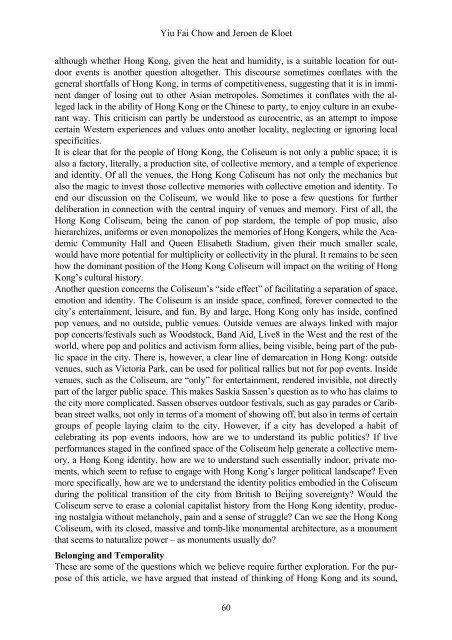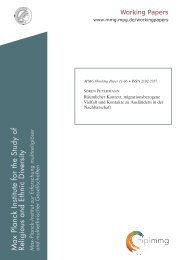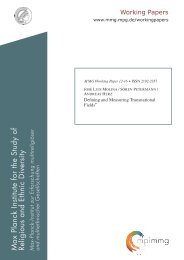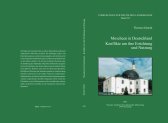Building Memories – A Study of Pop Venues in Hong Kong
Building Memories – A Study of Pop Venues in Hong Kong
Building Memories – A Study of Pop Venues in Hong Kong
You also want an ePaper? Increase the reach of your titles
YUMPU automatically turns print PDFs into web optimized ePapers that Google loves.
Yiu Fai Chow and Jeroen de Kloet<br />
although whether <strong>Hong</strong> <strong>Kong</strong>, given the heat and humidity, is a suitable location for outdoor<br />
events is another question altogether. This discourse sometimes conflates with the<br />
general shortfalls <strong>of</strong> <strong>Hong</strong> <strong>Kong</strong>, <strong>in</strong> terms <strong>of</strong> competitiveness, suggest<strong>in</strong>g that it is <strong>in</strong> imm<strong>in</strong>ent<br />
danger <strong>of</strong> los<strong>in</strong>g out to other Asian metropoles. Sometimes it conflates with the alleged<br />
lack <strong>in</strong> the ability <strong>of</strong> <strong>Hong</strong> <strong>Kong</strong> or the Ch<strong>in</strong>ese to party, to enjoy culture <strong>in</strong> an exuberant<br />
way. This criticism can partly be understood as eurocentric, as an attempt to impose<br />
certa<strong>in</strong> Western experiences and values onto another locality, neglect<strong>in</strong>g or ignor<strong>in</strong>g local<br />
specificities.<br />
It is clear that for the people <strong>of</strong> <strong>Hong</strong> <strong>Kong</strong>, the Coliseum is not only a public space; it is<br />
also a factory, literally, a production site, <strong>of</strong> collective memory, and a temple <strong>of</strong> experience<br />
and identity. Of all the venues, the <strong>Hong</strong> <strong>Kong</strong> Coliseum has not only the mechanics but<br />
also the magic to <strong>in</strong>vest those collective memories with collective emotion and identity. To<br />
end our discussion on the Coliseum, we would like to pose a few questions for further<br />
deliberation <strong>in</strong> connection with the central <strong>in</strong>quiry <strong>of</strong> venues and memory. First <strong>of</strong> all, the<br />
<strong>Hong</strong> <strong>Kong</strong> Coliseum, be<strong>in</strong>g the canon <strong>of</strong> pop stardom, the temple <strong>of</strong> pop music, also<br />
hierarchizes, uniforms or even monopolizes the memories <strong>of</strong> <strong>Hong</strong> <strong>Kong</strong>ers, while the Academic<br />
Community Hall and Queen Elisabeth Stadium, given their much smaller scale,<br />
would have more potential for multiplicity or collectivity <strong>in</strong> the plural. It rema<strong>in</strong>s to be seen<br />
how the dom<strong>in</strong>ant position <strong>of</strong> the <strong>Hong</strong> <strong>Kong</strong> Coliseum will impact on the writ<strong>in</strong>g <strong>of</strong> <strong>Hong</strong><br />
<strong>Kong</strong>’s cultural history.<br />
Another question concerns the Coliseum’s “side effect” <strong>of</strong> facilitat<strong>in</strong>g a separation <strong>of</strong> space,<br />
emotion and identity. The Coliseum is an <strong>in</strong>side space, conf<strong>in</strong>ed, forever connected to the<br />
city’s enterta<strong>in</strong>ment, leisure, and fun. By and large, <strong>Hong</strong> <strong>Kong</strong> only has <strong>in</strong>side, conf<strong>in</strong>ed<br />
pop venues, and no outside, public venues. Outside venues are always l<strong>in</strong>ked with major<br />
pop concerts/festivals such as Woodstock, Band Aid, Live8 <strong>in</strong> the West and the rest <strong>of</strong> the<br />
world, where pop and politics and activism form allies, be<strong>in</strong>g visible, be<strong>in</strong>g part <strong>of</strong> the public<br />
space <strong>in</strong> the city. There is, however, a clear l<strong>in</strong>e <strong>of</strong> demarcation <strong>in</strong> <strong>Hong</strong> <strong>Kong</strong>: outside<br />
venues, such as Victoria Park, can be used for political rallies but not for pop events. Inside<br />
venues, such as the Coliseum, are “only” for enterta<strong>in</strong>ment, rendered <strong>in</strong>visible, not directly<br />
part <strong>of</strong> the larger public space. This makes Saskia Sassen’s question as to who has claims to<br />
the city more complicated. Sassen observes outdoor festivals, such as gay parades or Caribbean<br />
street walks, not only <strong>in</strong> terms <strong>of</strong> a moment <strong>of</strong> show<strong>in</strong>g <strong>of</strong>f, but also <strong>in</strong> terms <strong>of</strong> certa<strong>in</strong><br />
groups <strong>of</strong> people lay<strong>in</strong>g claim to the city. However, if a city has developed a habit <strong>of</strong><br />
celebrat<strong>in</strong>g its pop events <strong>in</strong>doors, how are we to understand its public politics? If live<br />
performances staged <strong>in</strong> the conf<strong>in</strong>ed space <strong>of</strong> the Coliseum help generate a collective memory,<br />
a <strong>Hong</strong> <strong>Kong</strong> identity, how are we to understand such essentially <strong>in</strong>door, private moments,<br />
which seem to refuse to engage with <strong>Hong</strong> <strong>Kong</strong>’s larger political landscape? Even<br />
more specifically, how are we to understand the identity politics embodied <strong>in</strong> the Coliseum<br />
dur<strong>in</strong>g the political transition <strong>of</strong> the city from British to Beij<strong>in</strong>g sovereignty? Would the<br />
Coliseum serve to erase a colonial capitalist history from the <strong>Hong</strong> <strong>Kong</strong> identity, produc<strong>in</strong>g<br />
nostalgia without melancholy, pa<strong>in</strong> and a sense <strong>of</strong> struggle? Can we see the <strong>Hong</strong> <strong>Kong</strong><br />
Coliseum, with its closed, massive and tomb-like monumental architecture, as a monument<br />
that seems to naturalize power <strong>–</strong> as monuments usually do?<br />
Belong<strong>in</strong>g and Temporality<br />
These are some <strong>of</strong> the questions which we believe require further exploration. For the purpose<br />
<strong>of</strong> this article, we have argued that <strong>in</strong>stead <strong>of</strong> th<strong>in</strong>k<strong>in</strong>g <strong>of</strong> <strong>Hong</strong> <strong>Kong</strong> and its sound,<br />
60






